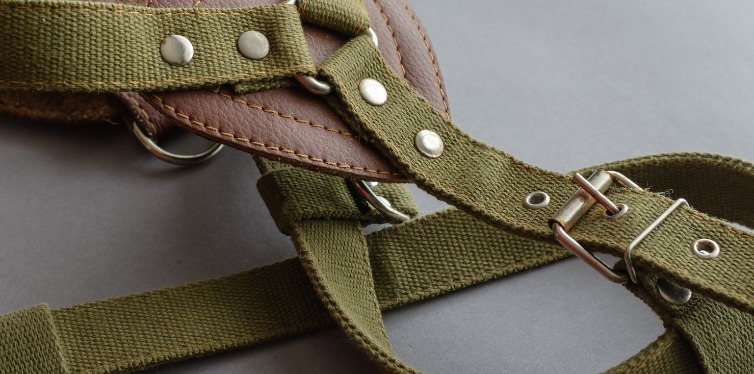Many dog owners use harnesses instead of collars to keep their dogs from escaping their leashes. If you own a Pomeranian, you need the perfect harness. “Perfect,” in this instance, refers to it being the most comfortable and secure option that also doesn’t negatively impact his health. Have you been wondering how to fasten a harness on a Pomeranian?
First, unsnap the buckle and lay the harness out flat on the ground. Next, place your dog in the middle of the harness and lift his front legs up and over the straps. Once his front legs are in place, clip the buckle closed while you secure the straps around his back. Make sure to adjust the straps accordingly so that they’re not too tight or too loose. Once everything is fastened, take your dog for a walk around the block and see how he likes it!
In this post, I’ll take you through the basics of how to put a harness on a Pomeranian, with some light thrown on how to choose the correct harness and its benefits along the way.
How to Put a Harness on a Pomeranian: 4 Different Harness Straps

If you are a first-time dog owner putting on a dog harness can be tricky, but with a little patience and practice, you will become a pro in no time! Let’s explore the four best Pomeranian harness straps along with their procedure to put on.
1. Standard Dog Harness
A typical standard harness has one loop around the ribs, another around the neck, and then a D-ring on the back to attach the leash.
Steps
The steps for putting on different types of harnesses vary. To begin, here are the instructions for a standard harness:
- Position yourself behind your dog, either standing or sitting, and coax him into following suit. Doing this when he’s calm will be easiest for both of you.
- First, put the harness over your dog’s head. Then, check to see that the D-ring is on his back. Next, fasten the wider loop (the one with the buckle), followed by putting it on the narrower loop.
- Take your dog’s leg and thread it through the first leg hole of the harness. The leg should now be wedged in between the loops that go around the neck and the ribs.
- After you put your dog’s leg through the appropriate harness hole, buckle it in so that it is snug. If you can’t easily close the buckle, loosen the strap a bit.
- After you buckle the harness, adjust it to fit your dog correctly. The straps should be tight enough that you can slip two fingers underneath them.
- You should also test the security of the harness by trying to pull it over your dog’s head.
2. Overhead Dog Harness
An overhead dog harness is designed to go over a dog’s head and fit its paws in separate loops. The harness is equipped with two ‘D’ rings, one on the top and one on the chest plate. This harness style can provide more control for strong or active dogs and support for dogs with mobility issues or injuries.
Steps
An over-the-head harness is the best way to secure your dog. Here’s how to properly fit it:
- Get your dog to sit next to you.
- Be sure to use the correct neck hole, then slide the harness over your dog’s head.
- Put each paw into a separate loop.
- Take the straps located behind your dog and lift them up.
- After you have fastened the buckle, adjust the harness to fit your dog snugly. The harness should not impede its movement but keep it safe.
3. Front Clip Dog Harness
The front-clip harness has a leash attachment in the front, over the dog’s chest. It is meant to stop pulling. Some are similar in design to the standard harness. In such cases, follow the steps of the standard harness.
Instead of having a divider between the dog’s legs, some front-clip harnesses have one loop around the ribs and a single chest strap.
Steps
If the front clip harness you have is of a later type, follow these steps:
- While your dog is sitting or standing calmly, kneel down to his right side.
- To put the harness on your dog, first, fit the loop over his head. The label should be sitting on his left shoulder, and then clip the leash to the ring in the center of his chest.
- Attach the belly strap to your dog’s belly by fastening it underneath its stomach.
- Be sure to adjust the harness to ensure a snug, comfortable fit for your dog. Additionally, you shouldn’t be able to easily pull it over his head.
4. Step-In Dog Harness
A step-in harness consists of harness loops and D-ring on the back. If you struggle with movement or if your dog is uncomfortable with things placed over its head, this is an ideal selection.
Steps
Follow these steps to put on step-in harnesses:
- Spread the harness on the ground, ensuring each section is unbuckled.
- Get your dog to sit close to the harness, and put their two front paws into the loops on the harness.
- Reach up and grab the saddle so that the buckle components sit on your dog’s shoulder blades.
- Ensure the straps are adjusted properly, so the harness fits snugly but not too tight.
What Makes a Good Pomeranian Harness?

Most owners wonder if Pomeranians can wear harnesses of all types. Yes, but there are a few key things to look for in a good Pomeranian dog harness.
- First, the fit should be adjustable to ensure a snug and comfortable fit for your pup.
- The material should also be durable and withstand some tugging from your furry friend.
- It should never put pressure on your dog’s throat.
- It’s also essential to have secure fastenings, such as buckle closures, to prevent your dog from slipping out of the harness.
- It’s always a good idea to choose a harness with a metal ring on the top to attach a leash for convenient handling and control during walks.
- Consider a harness that is water-resistant or even wet-fur-friendly to make bath time a breeze.
How to Choose the Right Pomeranian Harness

Choosing the suitable harness for your Pom puppy can be a bit challenging, as these small dogs’ fluff balls come in all shapes and sizes. Here are some key elements to keep in mind when selecting a harness:
Measure the Pomeranian Size
It’s essential to correctly measure your Pomeranian before choosing a harness size. You need body length, neck, and girth measurements, with girth being the most important.
To get an accurate measurement:
- Use a cloth tape to measure or even a piece of string that can be compared to a construction tape measure or ruler.
- Remember to also leave enough room for two fingers to fit between your Pomeranian’s chest and the harness.
The Pomeranians are a small dog breed with a relatively broad chest. Many Pomeranians only weigh between 3 and 9 lbs. So you’ll need to find the best harness that fits their tiny frame.
Select Permeable Material
Select harnesses with a breathable material like polyester soft mesh. Mesh harnesses are very comfortable, allow for excellent airflow, and are lightweight.
Easy On/Off
Find a harness that has adjustable straps or an adjustable velcro wrap; it will close with either quick-release buckles or velcro. These features make putting the harness on your Pom easy and taking it off just as fast.
Are Dog Harnesses Better Than Collars?

The trachea of a Pom is entirely encircled by cartilage rings that can be easily crushed by a jerk to his neck. Poms are also susceptible to tracheal collapse. It can be genetic or can happen from trauma to the trachea, such as neck injuries.
So, collaring Poms instead of harnessing that are having trouble breathing can worsen the problem.
Why Harnesses Are the Best Choice
Harnessing your Pom is the best choice due to the following reasons:
1. Keep Your Pom Safe
The best way to keep your Pomeranian safe on a leash is by using a harness that fits properly. A well-fitting harness will run along the shoulders, chest, and back without touching the dog’s neck.
2. Pressure Is Distributed Across the Body
The leash tension isn’t applied to only one area of the body when using a harness. The pressure is distributed evenly across sturdier areas with bones (rather than cartilage) that can handle the force.
3. Gives Better Control
In addition, it allows you to have greater command over your dog when he is leashed. You can keep him close by your side, prevent him from jumping, or rapidly bring him towards you in case of possible danger, all without putting pressure on his neck and causing any potential harm.
Why Collars Are Bad Choice
Most vets recommend no pull dog harness usage in Pomeranians instead of a collar due to the following drawbacks.
1. Hinders Breathing
If your Pom Gradually walks along an inclined platform such as a: escalator, a ramp, or something else, and he slides off to one side, he could potentially end up dangling by his neck. It would not only strangle him but also prevent him from breathing.
2. Affects the Windpipe
If your dog lunges sharply to the side during a walk, the force collar put on the neck can break his windpipe.
3. Injury
If your dog’s leash is dragging along the ground and gets stepped on, his neck could snap back and get seriously injured.
4. Can Break Up the Tracheal Rings
When your dog walks ahead of you, straining to go faster without proper training, he puts pressure on his trachea every time. Over time, this wears down the structure of the rings inside his trachea and can cause serious injury.
5. Lethal During Car Accident
If you connect your dog’s leash or collar to the car safety strap and have an accident, it will be fatal for him.
Final Thoughts
Keeping your Pomeranian safe and secure can be challenging, but with the right harness for your Pom and some practice, you can have peace of mind when out for a walk. Be sure to get the correct size harness for your Pom.
When putting the harness on your dog, be sure to have someone help you so that you can get it on correctly. With a bit of preparation, you’ll be able to keep your furry friend by your side safely and securely.





